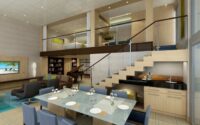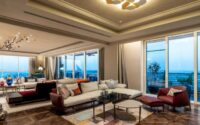Contemporary Beach House Interior Design: A Guide to Coastal Style
Contemporary beach house interior design is a style that seamlessly blends modern aesthetics with the relaxed and inviting atmosphere of coastal living. This design approach embraces clean lines, natural materials, and a light and airy color palette, creating a space that is both sophisticated and comfortable.
From the selection of furniture and furnishings to the incorporation of sustainable practices, this guide explores the key elements that define contemporary beach house interiors. It delves into the color palette, materials, lighting, and design strategies that contribute to a sense of flow and connection between indoor and outdoor spaces.
Incorporating Outdoor Living
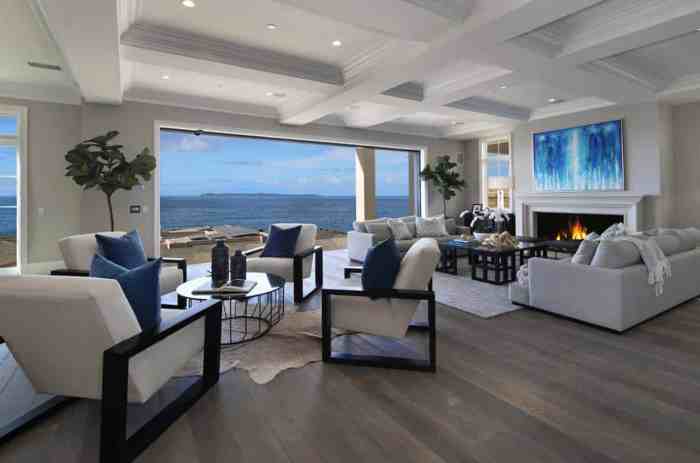
In a contemporary beach house, the indoor-outdoor connection is paramount. Blending the living spaces seamlessly with the surrounding natural beauty enhances the overall experience. The aim is to create a cohesive flow between the interior and exterior, maximizing the use of space and embracing the coastal lifestyle.
Creating a Seamless Flow
To achieve a seamless transition between the interior and exterior, consider using similar materials and color palettes for both spaces. This creates a sense of continuity and harmony. For example, if the living room features wood flooring, extend the same flooring onto the patio or deck.
Similarly, if the interior uses a neutral color palette, carry it over to the outdoor furniture and accessories.
Materials for Outdoor Living Spaces
The materials used for outdoor furniture and structures should be durable and weather-resistant. Some popular choices include:
- Teak wood:Known for its natural oil content, teak wood is highly resistant to decay and weathering. It also develops a beautiful silver patina over time.
- Wrought iron:Wrought iron is strong, durable, and adds a classic touch to outdoor spaces. It can be painted or left unfinished to create a rustic look.
- Aluminum:Lightweight and corrosion-resistant, aluminum is an excellent choice for outdoor furniture. It is also available in a wide range of colors and finishes.
- Synthetic wicker:Made from durable materials like polyethylene or vinyl, synthetic wicker is weather-resistant, easy to clean, and comes in a variety of styles.
Furniture and Lighting
Outdoor furniture should be comfortable and inviting, reflecting the relaxed beach house aesthetic. Consider incorporating:
- Lounge chairs and sofas:Perfect for relaxing and enjoying the views.
- Dining tables and chairs:For outdoor meals and entertaining.
- Fire pit or fireplace:Provides warmth and ambiance during cooler evenings.
- Outdoor lighting:Use a combination of ambient lighting, task lighting, and accent lighting to create a welcoming and functional space.
Outdoor Living Area Design
Here’s a plan for an outdoor living area adjacent to a contemporary beach house:
- Space:A spacious deck or patio with views of the ocean or garden.
- Furniture:A large sectional sofa with plush cushions, a coffee table, two lounge chairs, and a dining table with six chairs.
- Lighting:String lights strung across the deck, lanterns on the tables, and spotlights illuminating the surrounding landscaping.
- Materials:Teak wood decking, aluminum furniture, and woven wicker accents.
- Features:A built-in fireplace or fire pit, a small bar area with a sink and refrigerator, and a built-in planter box for lush greenery.
Sustainability and Eco-Friendly Design
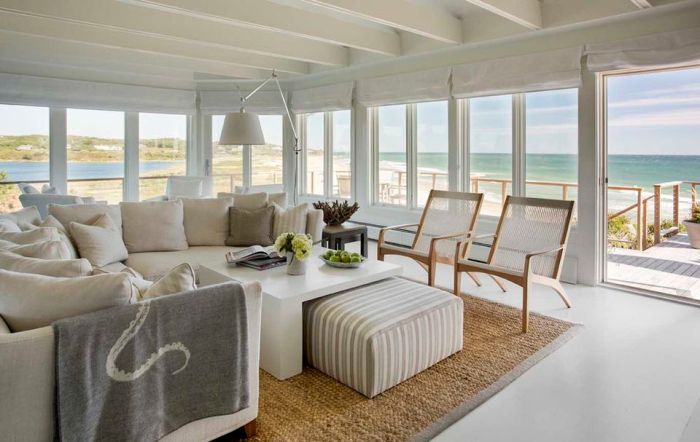
The contemporary beach house movement is increasingly embracing sustainable practices, recognizing the importance of minimizing environmental impact while maximizing enjoyment of the coastal environment. This shift is driven by a growing awareness of climate change and a desire to live in harmony with nature.
Eco-Friendly Materials
Sustainable materials are a key element in eco-conscious beach house design. These materials minimize environmental impact throughout their lifecycle, from sourcing and manufacturing to disposal.
- Recycled and Reclaimed Materials: These materials offer a unique aesthetic and reduce the need for new resources. Examples include reclaimed wood for flooring and furniture, recycled glass for countertops, and repurposed metal for accents.
- Sustainable Wood: Choosing sustainably harvested wood, certified by organizations like the Forest Stewardship Council (FSC), ensures that forests are managed responsibly.
- Bamboo: A rapidly renewable resource, bamboo is a strong, durable, and naturally beautiful material used for flooring, furniture, and structural elements.
- Cork: Cork is harvested from the bark of cork oak trees, a sustainable and renewable resource. It is used for flooring, wall coverings, and furniture, providing insulation and a natural aesthetic.
- Natural Stone: Locally sourced stone, such as granite or limestone, reduces transportation emissions and adds a timeless elegance to beach house interiors.
Energy-Efficient Appliances
Contemporary beach houses prioritize energy efficiency through the use of appliances that minimize energy consumption.
- Energy Star-Rated Appliances: Appliances certified by the Energy Star program meet strict energy efficiency standards, reducing energy consumption and lowering utility bills.
- Solar Panels: Installing solar panels on the roof can generate renewable energy, reducing reliance on fossil fuels and lowering carbon footprint.
- LED Lighting: LED lights are significantly more energy-efficient than traditional incandescent bulbs, reducing energy consumption and extending bulb life.
Sustainable Design Features
Sustainable design principles are integrated into the architecture and interior design of contemporary beach houses to maximize energy efficiency and minimize environmental impact.
- Passive Solar Design: This design strategy maximizes natural sunlight and heat gain during winter while minimizing heat gain during summer, reducing reliance on artificial heating and cooling.
- Cross-Ventilation: Designing the house with strategically placed windows and doors allows for natural airflow, reducing the need for air conditioning.
- Water Conservation: Water-efficient fixtures, such as low-flow showerheads and toilets, minimize water consumption, conserving this precious resource.
- Green Roofs: Installing a green roof, covered with vegetation, provides insulation, reduces stormwater runoff, and enhances the aesthetic appeal of the home.
Sustainable Design Principles, Contemporary beach house interior design
Sustainable design principles guide the choices made in building and designing a contemporary beach house, ensuring that the home is environmentally responsible and energy-efficient.
- Reduce, Reuse, Recycle: This principle emphasizes minimizing waste by reducing consumption, reusing materials, and recycling whenever possible.
- Minimize Environmental Impact: Sustainable design aims to minimize the impact of the home on the surrounding environment, including air and water quality, biodiversity, and energy consumption.
- Maximize Energy Efficiency: The design incorporates features and technologies that minimize energy consumption, such as passive solar design, cross-ventilation, and energy-efficient appliances.
- Promote Healthy Living: Sustainable design promotes a healthy living environment by using non-toxic materials, maximizing natural light, and creating spaces that encourage physical activity.
- Consider the Lifecycle of Materials: The environmental impact of materials is considered throughout their lifecycle, from sourcing and manufacturing to disposal.
Contemporary Beach House Trends
The contemporary beach house style is constantly evolving, reflecting changing tastes and technological advancements. This dynamic approach blends modern design principles with the relaxed, coastal vibe that defines beach living. Here are some key trends shaping the contemporary beach house of today:
Bold Colors and Metallic Accents
The use of bold colors is a defining feature of contemporary beach house design. While traditional beach houses often favored neutral tones, contemporary designs embrace vibrant hues like turquoise, coral, and teal. These colors bring a sense of energy and excitement to the space, reflecting the lively spirit of the coast.
Metallic accents, such as gold, silver, and copper, add a touch of sophistication and glamour. They can be incorporated through furniture, lighting, and accessories. The combination of bold colors and metallic accents creates a visually striking and modern aesthetic.
Sustainable Materials
Sustainability is increasingly important in all aspects of design, and contemporary beach houses are no exception. Architects and designers are incorporating eco-friendly materials such as reclaimed wood, bamboo, and recycled glass. These materials not only reduce the environmental impact of the house but also add a unique character and warmth to the interior.
The use of sustainable materials also aligns with the coastal lifestyle, emphasizing a connection with nature and responsible living.
Technology Integration
Technology plays a significant role in contemporary beach house design. Smart home features, such as automated lighting, climate control, and security systems, provide convenience and enhance the overall living experience. Integrated entertainment systems allow residents to enjoy their favorite movies and music throughout the house.
The seamless integration of technology creates a comfortable and connected living environment.
Evolution of the Style
Contemporary beach house design has evolved significantly from its earlier iterations. Past designs often featured a more traditional and rustic aesthetic, with heavy use of wood and natural materials. Contemporary designs are more minimalist and streamlined, with clean lines and a focus on functionality.
The use of bold colors, metallic accents, and sustainable materials reflects a modern approach to beach house design, blending coastal living with contemporary style.
Wrap-Up
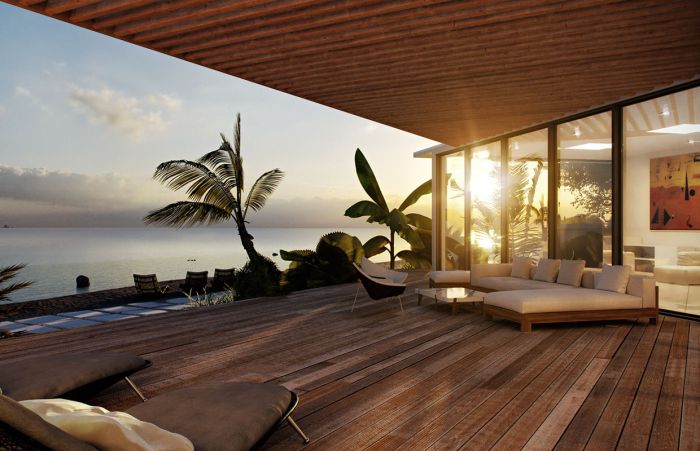
By embracing the principles of contemporary beach house design, you can create a home that is both stylish and functional, a sanctuary where you can relax, recharge, and enjoy the beauty of your surroundings. Whether you’re building a new home or simply refreshing your existing space, this guide provides valuable insights and inspiration for crafting a coastal haven that reflects your personal style.
Question & Answer Hub: Contemporary Beach House Interior Design
What are some popular colors for a contemporary beach house?
Neutral colors like white, beige, and gray are common choices for contemporary beach houses, while pastels like blue, green, and pink can add pops of color. Natural wood tones and earthy accents also complement the coastal aesthetic.
What are some must-have furniture pieces for a contemporary beach house living room?
Essential furniture pieces for a contemporary beach house living room include a comfortable sofa, a coffee table, an accent chair, and a media console. Consider pieces with clean lines and natural materials like wood or wicker.
How can I incorporate sustainable design principles into my contemporary beach house?
Sustainable design principles can be incorporated by using eco-friendly materials, energy-efficient appliances, and natural lighting. Consider using reclaimed wood, bamboo, or recycled materials for furniture and decor.

